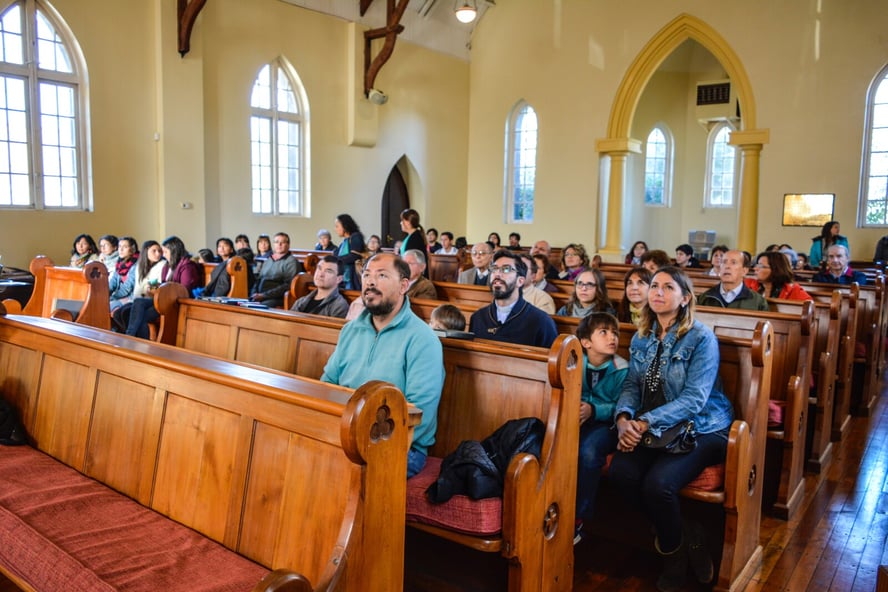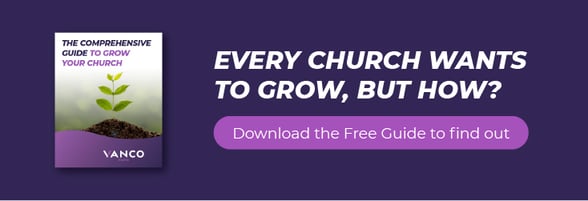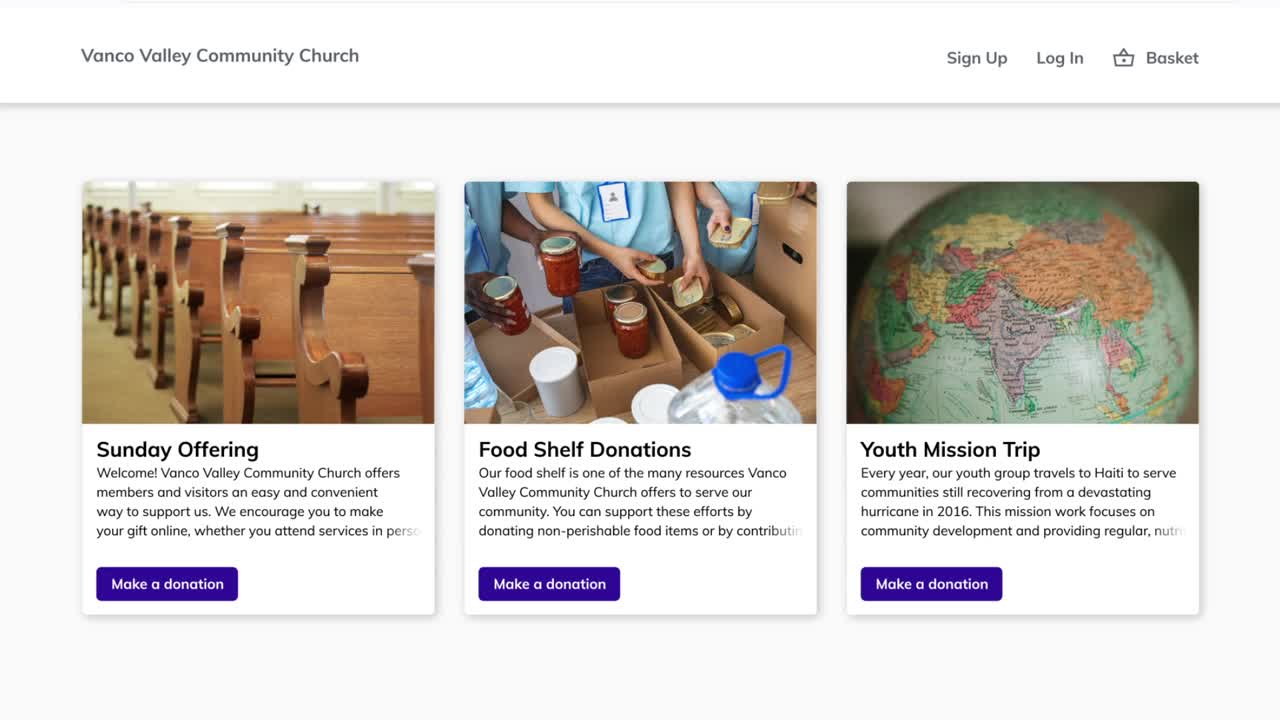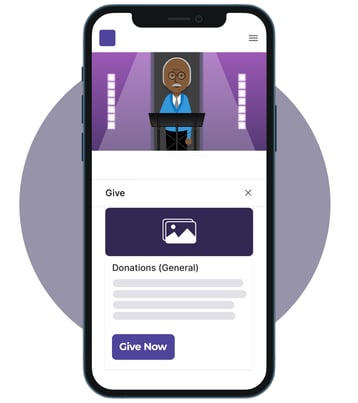 Tithes and offerings transcend mere religious rituals—they embody genuine faith. Delve into the Bible's teachings on tithes and offerings to enrich your spiritual journey. Interested in amplifying church tithing? We've curated top-tier strategies just for you. Moreover, we'll guide you through cutting-edge technologies that churches worldwide are harnessing to enhance their contributions.
Tithes and offerings transcend mere religious rituals—they embody genuine faith. Delve into the Bible's teachings on tithes and offerings to enrich your spiritual journey. Interested in amplifying church tithing? We've curated top-tier strategies just for you. Moreover, we'll guide you through cutting-edge technologies that churches worldwide are harnessing to enhance their contributions.
Table of Contents
- What the Bible Says About Tithes and Offerings
- Teaching About Tithes and Offerings
- How to Increase Church Tithing
- 7 Key Technologies to Help Grow Tithes and Offerings
What the Bible Says About Tithes and Offerings

Behind every act of Christian generosity is a story — a narrative of faith, devotion and tradition. Tithes and offerings hold more than just monetary value; they're the very essence of spiritual connectivity and community service. Journey with us into the heart of these rituals and their meanings and origins. Uncover the transcendent power they possess by gaining insights into the most common and impactful tithing and offering questions.
What Are Tithes and Offerings?
The act of giving, in the form of tithes and offerings, is a fundamental aspect of Christian religions. The word “tithe” comes from the Old English words “teogothian” and “tēotha,” which literally mean “one-tenth.” In the religious sense, a tithe is a voluntary donation of one-tenth of one’s belongings. Tithes differ from offerings. Offerings are donations that exceed what is owed, or what is over one-tenth.
Tithing is mentioned throughout the Bible, in both the Old and New Testaments. Exodus 35:5 is a passage that stands out. It reads “From what you have, take an offering for the LORD. Everyone who is willing is to bring to the LORD an offering.” The voluntary act of giving is a sacred teaching that helps the church fulfill its mission of providing aid to others within their community and around the world, maintaining facilities, paying church staff and demonstrating gratitude to God.
What Does Tithe Mean in the Bible?
Tithing is technically when we contribute 10 percent of what we earn to something. However, for many, tithing meaning is when people contribute some of their earnings to the church, whether or not that amounts to 10 percent of what they take home.
Looking for more context to help you understand the meaning of this critical word? Dive a little deeper and find out: What does tithe mean in the Bible? What are the origins of this term?
Origin of Tithing
In church, we often pass around tithing baskets and make contributions to the church. Today, tithes and offerings enable us to contribute to our local communities and help to fund our places of worship.
As mentioned earlier, this tradition dates far before many of the institutions we know today.
The tradition of tithing far predates English itself. In fact, tithing in Christianity predates the whole New Testament and is referenced in the Old Testament. Generosity is an important part of many faiths, so it’s not surprising that this tradition goes back so far.
Tithing Meaning in the Bible
So, what does tithe mean in the Bible? Generosity is often thought of as an important part of Christianity. In the Christian faith, Jesus famously once explained that a camel would have an easier time fitting through the eye of a needle than a rich man would have getting into heaven. As such, it isn’t surprising to learn that tithing is an important concept in the Christian Bible — and one that is mentioned several times. However, the way the Bible approaches tithing changes from the Old Testament to the New Testament. Moreover, how individuals now think about tithing can vary.
Old Testament
Tithing is explicitly mentioned and instructed in the Old Testament. For example, Leviticus 27:30 states that the land should be tithed to God, as everything on earth belongs to God.
The New Testament
In the New Testament, tithing has a different role. Tithing isn’t instructed, but there are plenty of themes of giving. In fact, Jesus once scorned those who put too much stock in tithing and not enough stock in just being good people. However, it’s important to note that Jesus wasn’t scorning people for tithing. In fact, he encouraged them to do both — to uphold justice, mercy and faithfulness in addition to their tithing.
So, what’s the lesson here? That might be a question for a theological debate, but it’s probably safe to say that generosity, faith, justice and mercy are all important parts of Christian faith for many denominations.
While some Christians today might not put much stock in the formal practice of tithing, supporting one’s community and place of worship is often a wonderful thing to do. Whether or not we’re called to tithe, the Bible certainly never discouraged it, except in cases where it took precedence over the important tenets of faith.
What Are the Purpose and Benefits of Tithes?
We’ve answered the question, “What are tithes and offerings?” But why do we give tithes and offerings? There are many reasons to give tithes and offerings in a place of worship. However, as churches work to recover from the pandemic’s negative effects, discovering how to increase church tithing is more important than ever. Churches have certainly witnessed generosity in their recoveries, but the reasons to tithe extend far beyond pandemic recovery. In fact, just a single tithe can provide substantial evidence of the benefits of giving for churches. Here’s a breakdown of the benefits of tithing and why we should tithe when possible.
Tithing Supports the Church’s Missions
Through a variety of missions and programs, churches are responsible for important support programs in communities across the country. Whether it's providing food and supplies to those in need or running programs to help enrich the community, funds are needed to help churches reach their goals. Money and supplies that are donated via tithes are used to support these goals.
Tithes Help to Maintain Church Facilities and Ongoing Operations
As nonprofit entities, church maintenance depends on the generosity of their communities and congregations. Church operating expenses, such as utility bills, salaries for church staff members and building rent or mortgage expenses, are covered, at least in part, by tithes.
The Bible Supports the Practice of Tithing
Tithing is mentioned several times throughout the Bible. Followers of the Lord’s words are advised to provide the Lord with an offering of a tithe of their fruits, wealth or bounty. In both testaments, tithing is considered a demonstration of one’s gratitude to the Lord.
Teaching About Tithes and Offerings
 Among nonprofit organizations, tithes and offerings are unique to churches. To help your congregation answer the question, “Why do we give tithes and offerings?”, it helps to provide tithes and offerings verses and explanations. To start, you can unlock the four essential types of giving and help church members grasp their profound impact.
Among nonprofit organizations, tithes and offerings are unique to churches. To help your congregation answer the question, “Why do we give tithes and offerings?”, it helps to provide tithes and offerings verses and explanations. To start, you can unlock the four essential types of giving and help church members grasp their profound impact.
Dive into the significance of what the Bible says about tithes and offerings and discover why it's crucial for churches to enlighten their flocks about tithes and offerings.
The Four Types of Biblical Giving
The Bible commands us to be generous givers and good stewards of our money. But did you know that there are several different types of Biblical giving? By now you’re familiar with the terms “tithe” and “offering” and you may use them interchangeably, but they are different. Let’s look at the four types of Biblical giving.
Tithes
Tithing is the type of giving that most people are familiar with. The Bible defines tithing as giving 10 percent of your income. Tithing has a long and rich history in the church, dating back to Abraham in the Old Testament. In Genesis after a battle, Abraham thanked God for giving him victory and expressed gratitude by giving 10 percent of what he owned.
In Proverbs 3, we’re told to honor our God with our wealth. Likewise, Leviticus 27 tells us to give 10 percent of what we have. Jesus spends time teaching about tithes and offerings and their importance in the New Testament in both the books of Matthew and Luke. Over and over in the Bible, we’re reminded how crucial it is to be generous with the wealth that God has blessed us with.
The Seed or Offerings
Seed offerings differ from tithing in a couple of ways. The key distinction is that tithing is a required amount you should give, while an offering amount is completely up to you. This giving is an opportunity for you to express your generosity, faith and gratitude regarding all that God has given you.
When it comes to offerings, there’s no particular percentage or number that is right for everyone. Instead, you should do what you feel is right for you, aiming to always be a good steward of your earthly possessions.
The First Fruits
Another kind of Biblical giving is known as first fruits giving. This sort of giving is discussed in Deuteronomy 14, where the people of God are told to tithe a portion of all the produce they grow that year. The idea behind this method of giving is to return a portion of the blessings God has bestowed upon us back to Him.
Whether it’s some extra from your bonus at work or part of your wages from a brand-new job, first fruits giving is a wonderful way to express gratitude to God. It’s also a practical way to help support your church and further its mission.
Alms-Giving
The last kind of Biblical giving we’ll discuss is alms-giving. Alms-giving is different from the other kinds of giving in that these funds should benefit the community around you. Alms-giving can take a variety of forms, including:
- Donating money to a local charity
- Volunteering your time at a community food bank or homeless shelter
- Donating gently used clothing items or nonperishable foods
- Helping assemble disaster relief kits or organizing supplies
In the Book of Matthew, believers in God are commanded to give in secret and to be certain not to brag about it or use it for selfish gain. When you participate in alms-giving, you should always make every effort to preserve and respect the dignity of those you are helping. This is critical to giving with a genuine heart.
Why It Is Important for Tithers to Give Willingly
Now that we’ve covered the differences between tithes and offerings, and first fruits and alms-giving, let’s talk about our attitudes toward giving. There’s no denying that we are called by God over and over in the Bible to honor Him by giving back with our wealth.
However, we shouldn’t give simply to check a box. The attitudes we have about giving and sharing our blessings are just as crucial as actually giving!
It’s important to understand exactly what kind of mindset we should have when tithing. Here are four important reasons why we should give willingly.
1. The Bible Says God Loves a Cheerful Giver
Paul says it best in 2 Corinthians when he notes that God loves a cheerful giver. He goes on to say that God can bless us abundantly so we have what we need and can do the work that God asks of us. Giving with a good attitude is simply one part of being a follower of God.
2. We Must Place God Above Money in Our Lives
In all aspects and areas of our lives, we are asked to place God first. This includes our wealth; after all, God is the one that has given it to us! In Matthew 6, Jesus tells us to first seek the Kingdom of God and the rest of these things will be added to us. Sharing our money and worldly possessions with God not only helps further the mission of Christ but also demonstrates that we’re willing to make sacrifices and do what it takes to always put God first.
3. Giving Helps Support Both Your Church and Community
Another reason to have a cheerful attitude about giving is that your efforts support both the church and the surrounding community. Giving doesn’t mean you simply surrender your money and it’s gone. In fact, it’s quite the opposite!
Through tithes and offerings, your money will go directly toward helping improve your church or a particular charity or community goal. You’ll be able to see how your giving supports the church’s mission and helps you to be a responsible steward of what you’ve been given by God.
4. Giving Helps Spread the Gospel
One of the best things about giving is that it helps spread the Word of God. Your offering can help do things like supply Bibles and support missionaries, as well as help cover church operating costs. Your gift goes directly to your faith community and allows the church to keep its doors open and further God's mission.
Tithes and Offerings Verses Explanation: Three Essential Passages to Consider
References that reveal Bible tithes and offering messages appear in both the Old and New Testaments. In fact, there are so many references to tithing in the Bible that an exhaustive list would be longer than this article! That said, although tithing is mentioned as early as Genesis, it’s the mention of tithes in Leviticus that cements tithing as law in the New Testament.
Below, you’ll find some of the most significant tithes and offerings verses and explanations in the Bible. Use these references in your teaching about tithes and offerings.
1. Genesis 14:18–20
“And he blessed Abram and said, ‘Blessed be Abram by God Most High, Possessor of heaven and earth; and blessed be God Most High, who has delivered your enemies into your hand!’ And Abram gave Him a tenth of everything.”
This passage represents the first mention of tithing in the Bible. Here, Abram has just returned from battle with his people and many goods in his lot. He is being blessed by the priest and king of Salem Melchizedek. In gratitude to God and his blessings, Abram presents Melchizedek with a tithe of his victory’s spoils.
2. Proverbs 3:9–10
“Honor the Lord with your wealth and with the first fruits of all your produce; then your barns will be filled with plenty, and your vats will be bursting with wine.”
This passage is an explanation of giving’s reciprocal nature, as is intended by the Lord. He rewards those who practice tithing in good faith. As fair fate and all goods are a direct result of the Lord’s blessings, it is only natural to give thanks for these blessings through tithing. Tithing in the New Testament is marked by a deep faith and obedience to the Lord and his will. Those who have faith and are obedient will be rewarded.
3. Leviticus 27:30–34
“A tithe of everything from the land, whether grain from the soil or fruit from the trees, belongs to the Lord; it is holy to the Lord.”
In this passage, Moses sets tithing as law when addressing the Israelites. Be it fruit of the trees or a healthy flock, a tenth of all goods is to be considered holy to the Lord. This offering is not considered a gift to the Lord, but an act of returning to Him what is rightfully his.
How to Increase Church Tithing
 Although many Christians struggle with tithing, it is part of our faith and should be acknowledged as a joy and a blessing. Some churches emphasize the need to give so much that it comes across as desperate or as if you are “buying your salvation.”
Although many Christians struggle with tithing, it is part of our faith and should be acknowledged as a joy and a blessing. Some churches emphasize the need to give so much that it comes across as desperate or as if you are “buying your salvation.”
By refocusing your church's messaging on tithing, you can increase church giving and foster a community of biblically minded individuals.
Read on for advice on how to increase church tithing.
1. Stress the Importance of the Tithe
Participation in the tithe was a requirement of Old Testament law. The Israelites were to give 10 percent of their crops and livestock to the temple. This requirement of tithing became a regular practice of Christianity.
Leviticus 27:30 says, “Every tithe of the land, whether of the seed of the land or of the fruit of the trees, is the Lord’s; it is holy to the Lord." It is important for churches to emphasize the biblical roots of giving.
Many members of a congregation either feel as if the tithe is unimportant or as if the church is seeking financial support. When teaching about tithes and offerings, it is especially important to share the biblical reasoning for tithing.
Make sure your church frames giving properly. You are inviting congregants to participate in the blessing of tithing rather than asking for a full donation basket.
2. Don't Always Talk About Fundraising
When donors begin to feel as if they are constantly being bombarded with donation requests in addition to tithes and offerings, this is a phenomenon called "donor fatigue."
Fatigued donors feel drained and have little emotional investment to make purposeful donations. To reduce donor fatigue, don't always talk about the need for monetary donations to the church.
Constantly asking for funds makes you seem desperate. It also makes congregants feel as if you only value their financial contributions and not the community and fellowship that they add to the church.
3. Biblical Stewardship
By shaping messaging around biblical stewardship, you can share the importance of living a life of giving. This also removes the pressure on your congregation to give. Biblical stewardship is taking the gifts God has planted in your life and using those gifts to continue to build and glorify His kingdom.
Christians are blessed by Jesus's sacrifice and are expected to bring all they have to their Lord and trust in Him. Christians should feel secure in sharing their worldly treasures with God and His church. Viewing tithes and offerings as this level of trust allows followers to take one step closer to Christ by bringing what we have before Him.
It can be difficult to keep God’s plan in focus when churches push messages about numeric goals while passing around the donation basket. The messaging of biblical stewardship allows congregants to bring their riches to God to further glorify Him.
4. Provide Financial Coaching for the Church Community
Many churches offer services such as counseling or financial coaching to congregants. These additional learning opportunities allow the church to provide valued resources.
Through free coaching services, churches can enlist experienced faith-driven financial advisors to help families manage their finances. These services allow the church to give back to its community.
Financial coaching through the church can be used to help families be financially responsible and stay afloat. During these coaching classes, financial coaches can encourage participants to plan tithes and offerings according to their budgets.
5. Share Blessings That Tithes Have Bestowed
When the church's financial burdens leak into teachings, it can make the tithe feel more like a burden than a blessing. It is important for church communities to discuss donating as a way of support rather than an obligation.
This can be done by sharing the stories of blessings bestowed through funds previously raised through tithes and offerings. By sharing an impactful story, people will feel much more motivated to give.
You can put a purpose behind the donation by providing testimonies. This can be sharing stories from families who are financially supported by the church. Sharing stories from missionary trips also put a sense of purpose behind the donation.
People are willing to part with their hard-earned income if they know the blessings can work toward God's plan. The greatest ways to encourage church donations is to show the blessings that are bestowed with donations and to be sure congregants know what the Bible says about tithes and offerings.
6. Giving Is About Trusting
Tithes and offerings are opportunities for you to help grant blessings on earth. Giving is not about money, it's about trusting in God.
The tithe is about trust. The concept is about giving what you have, not a set amount. For someone with everything versus someone with nothing, the tithe should still be challenging. Proverbs 11:24 says, "One gives freely, yet grows all the richer; another withholds what he should give, and only suffers want."
Tithing is not about being fiscally unwise. It's about being willing to give freely. It is about acknowledging that what we have is because of God and that we can give it up to further His plans. By putting your sacrifice before Him, you are showing you are willing to be a tool for His plan in His kingdom.
7. Engage All Generations
When thinking about philanthropists in your church community, think of married couples or older members of your church. These individuals are settled and have more flexibility in their income status.
However, it is important to target fundraising campaigns at people in all stages of life. By including all generations in your message of giving, you increase your donor base.
8. Youth Giving Initiative
One idea to produce long-term benefit for your church community is to engage in a youth giving initiative. Your church can challenge youth group participants to fundraise or donate up to a set figure. This is a fun and competitive way to get young people involved in tithes and offerings.
Typically, people in the youth group are not working full-time; they are saving money from part-time jobs, holiday gifts or allowances. A youth initiative is not expected to bring in high-dollar donations unless parents are involved in making the donations.
Encouraging giving at a young age can help to foster a spirit of gratitude and giving among a new generation.
9. Long-Term Growth
Instilling a love for and habit of philanthropy at a young age can cultivate lifelong donors for your congregation.
By inviting youth into a generous church culture, you can establish the habit of giving in other generations. Your youth fundraising campaign may not collect large donations, but by engaging young church members, you are creating a new donor base that will grow as these individuals enter the workforce.
10. Advertise Short-Term Campaigns for a Cause
Congregants feel rewarded knowing their financial contributions through tithes and offerings create positive change. That is why creating a short-term campaign for a specific cause can lead to a jolt in church donations. Some ideas for short-term campaigns can include:
- Hosting an annual Christmas giving tree to provide toys to children within families undergoing financial struggles
- Sending a group of teens and young adults on a mission trip to share the gospel
- Providing a meal for first responders or a local homeless shelter
By providing a goal and purpose behind donations, people will begin to take ownership of that cause. Donations become more valued with a purpose or vision behind them. Short-term campaigns for a cause are also an effective way of shaking off donor fatigue.
11. Promote Giving with an Event
Promoting donations outside of weekly church services is a great idea to boost numbers and build community among your congregation. By promoting giving with an event, you provide a platform to bring people together and focus on the church’s message and vision.
An event outside of regular services encourages weekly donors to make additional contributions beyond regular tithes and offerings. It also encourages people outside the congregation to make contributions and possibly join the church.
12. Online Virtual Event
Hosting a large in-person event may have a sizable cost. Creating a special occasion to highlight the spirit of giving can be done through an online event. Through online payment methods, you can encourage donations throughout the duration of your virtual event.
Some ideas for online virtual fundraisers for your church include bringing in a special speaker, having a virtual worship night featuring the church band or hosting a roundtable. At a roundtable, congregants get to engage in active dialogue with members of the church staff about the gospel.
13. In-Person Fundraiser
In-person events can raise money through ticket sales and bonus activities such as silent auctions or open donation opportunities. Churches can host in-person events such as churchwide dinners, church concerts or keynote speakers.
In-person fundraisers allow churches to set prices for a profit or rely solely on donations to reach financial goals. Ticket sales and bonus activities may not raise funds with a solely generous intent. However, they are very effective at helping to set goals and make projections for profit from in-person events.
Community events such as community dinners, concerts and speakers allow congregants to gather. At these events, printed materials can showcase information for online giving and a short pitch can be given on the collection. It is important that the focal point of this kind of event is not on dollar amounts.
14. Showing Gratitude
Efforts to increase church giving do not have to mean pushing your congregation to give more through tithes and offerings at weekly services. Building a church centered around philanthropy is about more than wanting the donation basket to be full. Through effective framing of the tithe, you can encourage a generous church community. Sending a thank-you message for all types of donations helps promote generosity within your church.
15. Navigate the Delicate Balance: The Church's Money Talk
The sanctuary of a church is, first and foremost, a haven for spiritual growth and the teachings of Jesus. But like any haven, it requires support to thrive. For many church leaders, weaving the necessity of funds into their spiritual narratives is a delicate task. How do you bridge the sacred with the practical? We've made it simpler with two essential tools:
- 36 Tithe and Offering Messages Chuches Swear By: Discover messages and verses that enlighten congregations about tithing.
- 105 Amazing Church Letter Samples: Never be at a loss for words again. Our free eBook equips you with sample letters, templates and techniques to make financial conversations graceful and effective.
16. Captivate the Congregation: The Power of Visual Aesthetics
Beautiful visuals aren’t just for galleries; they evoke emotions and inspire actions. For churches, an aesthetically pleasing presentation during offerings can spark a deeper generosity from the congregation. By using captivating visuals, you enhance the worship experience and encourage more heartfelt giving.
Your Answer to Elegant Offerings: Dive into Vanco's serene video ambiance. Designed to envelop your church in a calming atmosphere, it will inspire giving. Select from our melodic version or the silent loop for your unique touch.
17. Grow Your Flock
Current tithes and offerings can only carry a church so far. To truly expand their missions, churches must look beyond the present, fostering an environment that pulls newcomers into their flocks. With each addition, the tithes and offerings swell, fueling the mission’s expansion.
But Where to Begin? Start Here:
- Free Welcome Materials to Turn Visitors into Members: Crafting welcoming material isn't easy, but it's crucial. Our kit simplifies the process, providing you with connection card templates, verse cards, quotes and welcome message templates. Adapt them to your liking and watch newcomers feel at home.
- The Comprehensive Guide to Church Growth: With membership dwindling but belief in God remaining high, it’s time to re-strategize. Our guide presents proven tactics for churches to rejuvenate and prosper.

18. Practice Strong Financial Stewardship
For a church to thrive, two elements stand out: trust and connection. Members must witness their tithes and offerings being used judiciously, and they need to feel emotionally tied to the causes the church supports. Strong communication is vital. Show the impact; don't just narrate it. If members sense a disconnect or financial mismanagement, they might look elsewhere to contribute. While some view tithing strictly for churches, not all share this conviction. Church leaders must champion transparent financial stewardship and consistently connect members to the heartbeats of church-led initiatives.
This might be easier said than done. Talking about money and stewardship is not a comfortable topic for church leaders. Stewardship isn’t usually what inspired church leaders to their work in the first place, but it is vital.
Because talking finances can make anyone squirm, we built a definitive eBook on stewardship to help. From 8 nonnegotiable rules, 11 revenue goldmines to a proven 17-step plan, everything you need is packed inside. Ready for a breakthrough?
19. Legacy Giving
In addition to tithes and offerings supplemented by additional church events and campaigns to raise money, legacy giving is an increasingly important funding source for churches. Legacy giving involves donors bequeathing property to churches in the form of stock, property, land and artwork. These gifts often honor or memorialize specific individuals.
These types of gifts go beyond tithes and offerings, so it is important to create formal plans and instructions to govern them. You and the donors should clarify:
- What types of programs will the funds be used for? Remember: church priorities, needs and programs may change in the future.
- How may the church spend the money, for example, will there be a review process?
- How will the gift be recognized, for example, with a physical memorial?
- Most important, how will the church acknowledge these gifts? Be sure you have a process for tactfully and respectfully thanking donors for these critical gifts.
20. Educate Yourself on the Latest Tithing Statistics
In the evolving landscape of church donations, the pulse of tithing trends beats louder than ever. Consider this: electronic donations are now embraced by 10 to 25 percent of your congregation, and a staggering 77 percent of churches have stepped into the world of online giving. As leaders, harnessing this data can illuminate pathways to amplify generosity.
That’s why we’ve compiled dozens of stats on church tithes and offerings to help leaders understand key statistics they need to know to grow giving. In the resource, we’ve neatly collated all the critical stats and offer further guidance on how to adapt to the latest trends.
7 Key Technologies to Help Grow Tithes and Offerings
From the swipe of a card to the click of a button, tithing in the 21st century is an evolving art. Here, we unpack the varied, modern ways your congregation can contribute, merging age-old traditions with the convenience of today's technology.
1. Online Giving Pages

Online donation pages have revolutionized church contributions, offering a dynamic platform that not only facilitates but also enhances generosity.
These platforms champion cause-based giving, allowing members to connect more deeply with specific initiatives that resonate with their personal values. By allowing donors to see and select where their contributions go, churches are fostering a heightened sense of purpose and involvement.
Moreover, the ubiquitous accessibility of online giving pages ensures tithes and offerings aren’t constrained to a specific time or place. Whenever inspiration strikes, be it during a moving sermon or a quiet reflection at home, members can seamlessly act on that urge, strengthening their bond with the church's mission.
Want to See How Online Giving Pages Work?
Take a few minutes to watch this video!
2. Automatic Giving
 To make tithes and offerings easy for donors, enable individuals to set amounts to donate automatically each week or month. These recurring payment plans can help you better forecast donations for the year. Automatic giving enables you to look ahead when defining projects supported by giving.
To make tithes and offerings easy for donors, enable individuals to set amounts to donate automatically each week or month. These recurring payment plans can help you better forecast donations for the year. Automatic giving enables you to look ahead when defining projects supported by giving.
If you're interested in finding tested techniques for boosting recurring gifts, check out this free guide to get started.
Learn How to Unlock Generosity with Automatic Giving.
3. Donations at Your Fingertips

Many people no longer carry cash or checkbooks. Through online giving, you can make donating as easy for donors as clicking a button.
Online giving often produces an increase in donations because credit cards and digital payment methods have grown in popularity. By enabling mobile giving, you provide a quick and accessible way to donate.
Mobile giving apps can also come with additional features that simplify virtual services. This resource covers just a few of those features.
4. Boost Tithes Through Texts

In today’s fast-paced digital age, convenience often dictates action. Many members sincerely intend to give, but they lead busy lives and sometimes the process isn’t as streamlined as they’d wish.
Enter text-to-give software for churches. By providing congregants with a swift, secure method to contribute via their smartphones, churches tap into the habits of modern donors. This easy-to-use system ensures no missed opportunities, leading to an uptick in tithes and offerings. The result? A seamless blending of technology with tradition, ensuring your church's mission prospers.
See How Donors Can Send Tithes and Offerings in 4 Simple Steps!
5. In-Livestream Giving
 Today's worship often resonates through screens, reaching hearts miles apart. But while the sermon's spirit remains unchanged, the method of giving evolves. Enter in-livestream giving — a tool not just for ease but for capturing fleeting moments of inspiration. Virtual attendees, a pulsating heartbeat of our modern congregations, can now weave their offerings into their worship seamlessly, making generosity a spontaneous, integral part of the digital worship experience.
Today's worship often resonates through screens, reaching hearts miles apart. But while the sermon's spirit remains unchanged, the method of giving evolves. Enter in-livestream giving — a tool not just for ease but for capturing fleeting moments of inspiration. Virtual attendees, a pulsating heartbeat of our modern congregations, can now weave their offerings into their worship seamlessly, making generosity a spontaneous, integral part of the digital worship experience.
Watch How In-Livestream Tithes and Offerings Capture Generosity.
6. No Cash? No Problem! Swipe Your Way to Blessings
 In an era dominated by plastic and digital payments, churches have an opportunity to evolve. While many members and guests may not always have cash on hand, most carry cards. Mobile card readers stationed in sanctuaries bridge this gap, allowing immediate, hassle-free offerings.
In an era dominated by plastic and digital payments, churches have an opportunity to evolve. While many members and guests may not always have cash on hand, most carry cards. Mobile card readers stationed in sanctuaries bridge this gap, allowing immediate, hassle-free offerings.
For online fundraisers, these devices capture the generosity of nonmembers who might not have established recurring giving methods. By offering an effortless swipe or tap, churches can effectively foster a culture of giving, no matter the format.
7. Event Ticketing Today for a Thriving Tomorrow

The essence of a church isn't confined to its Sunday services. Often, it's the community events that truly radiate its spirit outward. Church event ticketing provides an avenue to supplement tithes and offerings and is a strategic initiative to organize community outreach more efficiently. By hosting fundraisers, the church can reduce its dependence on traditional offering plates, ensuring diversified financial stability.
Moreover, these events serve as windows into the church's vibrant community life, igniting curiosity and drawing new faces into its fold. It's a harmonious blend of fiscal prudence and genuine community engagement.
















